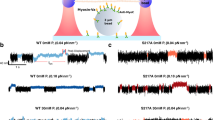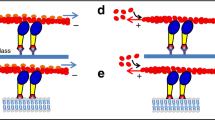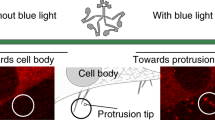Abstract
Complex forms of cellular motility, including cell division, organelle trafficking or signal amplification in the auditory system, require strong coordination of the myosin motors involved. The most basic mechanism of coordination is via direct mechanical interactions of individual motor heads leading to modification of their mechanochemical cycles. Here we used an optical trap–based assay to investigate the reversibility of the force-generating conformational change (power stroke) of single myosin-Va motor heads. By applying load to the head shortly after binding to actin, we found that, at a certain load, the power stroke could be reversed, and the head fluctuated between an actin-bound pre– and a post–power stroke conformation. This load-dependent mechanical instability might be critical to coordinate the heads of processive, dimeric myosin-Va. Nonlinear response to load leading to coordination or oscillations amongst motors might be relevant for many cellular functions.
This is a preview of subscription content, access via your institution
Access options
Subscribe to this journal
Receive 12 print issues and online access
$189.00 per year
only $15.75 per issue
Buy this article
- Purchase on Springer Link
- Instant access to full article PDF
Prices may be subject to local taxes which are calculated during checkout




Similar content being viewed by others
References
Sellers, J.R. & Veigel, C. Walking with myosin V. Curr. Opin. Cell Biol. 18, 68–73 (2006).
Mehta, A.D. et al. Myosin-V is a processive actin-based motor. Nature 400, 590–593 (1999).
Sakamoto, T., Webb, M.R., Forgacs, E., White, H.D. & Sellers, J.R. Direct observation of the mechanochemical coupling in myosin Va during processive movement. Nature 455, 128–132 (2008).
Veigel, C., Wang, F., Bartoo, M.L., Sellers, J.R. & Molloy, J.E. The gated gait of the processive molecular motor, myosin V. Nat. Cell Biol. 4, 59–65 (2002).
Yildiz, A. et al. Myosin V walks hand-over-hand: Single fluorophore imaging with 1.5-nm localization. Science 300, 2061–2065 (2003).
De La Cruz, E.M., Wells, A.L., Rosenfeld, S.S., Ostap, E.M. & Sweeney, H.L. The kinetic mechanism of myosin V. Proc. Natl. Acad. Sci. USA 96, 13726–13731 (1999).
Rosenfeld, S.S. & Sweeney, H.L. A model of myosin V processivity. J. Biol. Chem. 279, 40100–40111 (2004).
Volkmann, N. et al. The structural basis of myosin V processive movement as revealed by electron cryomicroscopy. Mol. Cell 19, 595–605 (2005).
Coureux, P.D., Sweeney, H.L. & Houdusse, A. Three myosin V structures delineate essential features of chemo-mechanical transduction. EMBO J. 23, 4527–4537 (2004).
Walker, M.L. et al. Two-headed binding of a processive myosin to F-actin. Nature 405, 804 (2000).
Burgess, S. et al. The prepower stroke conformation of myosin V. J. Cell Biol. 159, 983–991 (2002).
Forkey, J.N., Quinlan, M.E., Shaw, M.A., Corrie, J.E.T. & Goldman, Y.E. Three-dimensional structural dynamics of myosin V by single-molecule fluorescence polarization. Nature 422, 399–404 (2003).
Toprak, E. et al. Defocused orientation and position imaging (DOPI) of myosin V. Proc. Natl. Acad. Sci. USA 103, 6495–6499 (2006).
Dunn, A.R. & Spudich, J.A. Dynamics of the unbound head during myosin V processive translocation. Nat. Struct. Mol. Biol. 14, 246–248 (2007).
Cappello, G. et al. Myosin V stepping mechanism. Proc. Natl. Acad. Sci. USA 104, 15328–15333 (2007).
Uemura, S., Higuchi, H., Olivares, A.O., De La Cruz, E.M. & Ishiwata, S. Mechanochemical coupling of two substeps in a single myosin V motor. Nat. Struct. Mol. Biol. 11, 877–883 (2004).
Shiroguchi, K. & Kinosita, K. Myosin V walks by lever action and Brownian motion. Science 316, 1208–1212 (2007).
Rief, M. et al. Myosin-V stepping kinetics: a molecular model for processivity. Proc. Natl. Acad. Sci. USA 97, 9482–9486 (2000).
Gebhardt, J.C.M., Clemen, A.E.M., Jaud, J. & Rief, M. Myosin-V is a mechanical ratchet. Proc. Natl. Acad. Sci. USA 103, 8680–8685 (2006).
Carter, N.J. & Cross, R.A. Mechanics of the kinesin step. Nature 435, 308–312 (2005).
Veigel, C., Schmitz, S., Wang, F. & Sellers, J.R. Load-dependent kinetics of myosin-V can explain its high processivity. Nat. Cell Biol. 7, 861–869 (2005).
Finer, J.T., Simmons, R.M. & Spudich, J.A. Single myosin molecle mechanics-piconewton forces and nanometre steps. Nature 368, 113–119 (1994).
Veigel, C., Bartoo, M.L., White, D.C.S., Sparrow, J.C. & Molloy, J.E. The stiffness of rabbit skeletal actomyosin cross-bridges determined with an optical tweezers transducer. Biophys. J. 75, 1424–1438 (1998).
Molloy, J.E., Burns, J.E., Kendrick-Jones, J., Tregear, R.T. & White, D.C.S. Movement and force produced by a single myosin head. Nature 378, 209–212 (1995).
Veigel, C. et al. The motor protein myosin-I produces its working stroke in two steps. Nature 398, 530–533 (1999).
Robblee, J.P., Cao, W.X., Henn, A., Hannemann, D.E. & De La Cruz, E.M. Thermodynamics of nucleotide binding to actomyosin V and VI: a positive heat capacity change accompanies strong ADP binding. Biochemistry 44, 10238–10249 (2005).
Kad, N.M., Trybus, K.M. & Warshaw, D.M. Load and Pi control flux through the branched kinetic cycle of myosin V. J. Biol. Chem. 283, 17477–17484 (2008).
Takagi, Y., Shuman, H. & Goldman, Y.E. Coupling between phosphate release and force generation in muscle actomyosin. Phil. Trans. R. Soc. Lond. B 359, 1913–1920 (2004).
Moore, J.R., Krementsova, E.B., Trybus, K.M. & Warshaw, D.M. Myosin V exhibits a high duty cycle and large unitary displacement. J. Cell Biol. 155, 625–635 (2001).
Purcell, T.J., Sweeney, H.L. & Spudich, J.A. A force-dependent state controls the coordination of processive myosin V. Proc. Natl. Acad. Sci. USA 102, 13873–13878 (2005).
Huxley, A.F. & Simmons, R.M. Proposed mechanism of force generation in striated muscle. Nature 233, 533–538 (1971).
Oguchi, Y. et al. Load-dependent ADP binding to myosins V and VI: implications for subunit coordination and function. Proc. Natl. Acad. Sci. USA 105, 7714–7719 (2008).
Veigel, C., Molloy, J.E., Schmitz, S. & Kendrick-Jones, J. Load-dependent kinetics of force production by smooth muscle myosin measured with optical tweezers. Nat. Cell Biol. 5, 980–986 (2003).
Howard, J. Mechanics of Motor Proteins and the Cytoskeleton 76–89 (Sinauer, Sunderland, Massachusetts, USA, 2001).
Clemen, A.E.M. et al. Force-dependent stepping kinetics of myosin-V. Biophys. J. 88, 4402–4410 (2005).
Syed, S., Snyder, G.E., Franzini-Armstrong, C., Selvin, P.R. & Goldman, Y.E. Adaptability of myosin V studied by simultaneous detection of position and orientation. EMBO J. 25, 1795–1803 (2006).
Forgacs, E. et al. Kinetics of ADP dissociation from the trail and lead heads of actomyosin V following the power stroke. J. Biol. Chem. 283, 766–773 (2008).
Hannemann, D.E., Cao, W.X., Olivares, A.O., Robblee, J.P. & De La Cruz, E.M. Magnesium, ADP, and actin binding linkage of myosin V: evidence for multiple myosin V-ADP and actomyosin V-ADP states. Biochemistry 44, 8826–8840 (2005).
Vilfan, A. Elastic lever-arm model for myosin V. Biophys. J. 88, 3792–3805 (2005).
Nyitrai, M.G.M.A. Adenosine diphosphate and strain sensitivity in myosin motors. Phil. Trans. R. Soc. Lond. B 359, 1867–1877 (2004).
Nishizaka, T., Miyata, H., Yoshikawa, H., Ishiwata, S. & Kinosita, K. Unbinding force of a single motor molecule of muscle measured using optical tweezers. Nature 377, 251–254 (1995).
Duke, T.A.J. Molecular model of muscle contraction. Proc. Natl. Acad. Sci. USA 96, 2770–2775 (1999).
Shimamoto, Y., Suzuki, M. & Ishiwata, S. Length-dependent activation and auto-oscillation in skeletal myofibrils at partial activation by Ca2+. Biochem. Biophys. Res. Commun. 366, 233–238 (2008).
Hudspeth, A.J. & Gillespie, P.G. Pulling springs to tune transduction—adaptation by hair-cells. Neuron 12, 1–9 (1994).
Kruse, K. & Julicher, F. Oscillations in cell biology. Curr. Opin. Cell Biol. 17, 20–26 (2005).
van Mameren, J., Vermeulen, K.C., Gittes, F. & Schmidt, C.F. Leveraging single protein polymers to measure flexural rigidity. J. Phys. Chem. B 113, 3837–3844 (2009).
Colquhoun, D. & Sigworth, F.J. Practical analysis of records. in. Single Channel Recording (eds. Sakmann, B. & Neher, E.) 558–563 (Plenum Press, New York, USA, 1995).
Acknowledgements
We thank C. Schmidt and J. Molloy for stimulating discussions, E. Harvey for technical assistance and J. Hammer III (Laboratories of Cell Biology, National Heart, Lung, and Blood Institute, US National Institutes of Health) for kindly supplying the myosin-Va clone. We are also grateful to the UK Medical Research Council, The Royal Society UK and the US National Institutes of Health for grant support.
Author information
Authors and Affiliations
Contributions
J.R.S. expressed and purified MVS1; C.V. carried out experiments and data analysis; J.R.S. and C.V. wrote the paper.
Corresponding author
Ethics declarations
Competing interests
The authors declare no competing financial interests.
Supplementary information
Supplementary Text and Figures
Supplementary Figures 1–5, Supplementary Table 1 and Supplementary Discussion (PDF 8752 kb)
Rights and permissions
About this article
Cite this article
Sellers, J., Veigel, C. Direct observation of the myosin-Va power stroke and its reversal. Nat Struct Mol Biol 17, 590–595 (2010). https://doi.org/10.1038/nsmb.1820
Received:
Accepted:
Published:
Issue Date:
DOI: https://doi.org/10.1038/nsmb.1820
This article is cited by
-
A mutation in switch I alters the load-dependent kinetics of myosin Va
Nature Communications (2023)
-
Multistep orthophosphate release tunes actomyosin energy transduction
Nature Communications (2022)
-
Mechanism of contraction rhythm homeostasis for hyperthermal sarcomeric oscillations of neonatal cardiomyocytes
Scientific Reports (2020)
-
A modular DNA scaffold to study protein–protein interactions at single-molecule resolution
Nature Nanotechnology (2019)
-
Effect of myofibril passive elastic properties on the mechanical communication between motor proteins on adjacent sarcomeres
Scientific Reports (2019)



